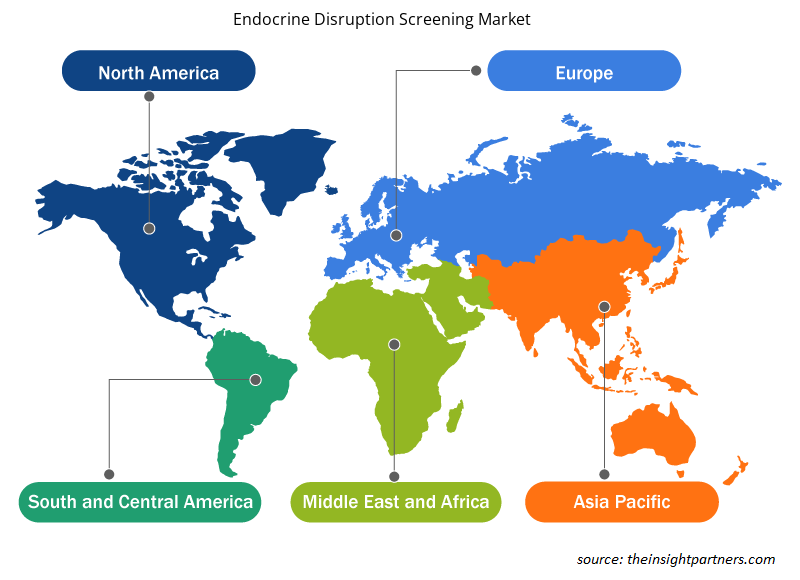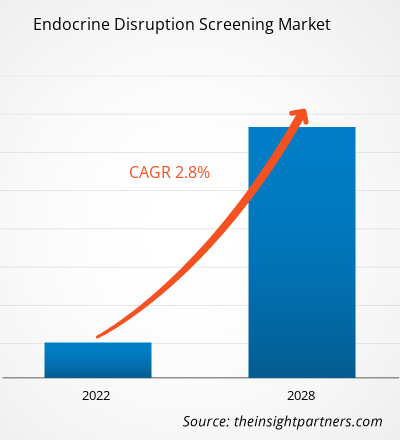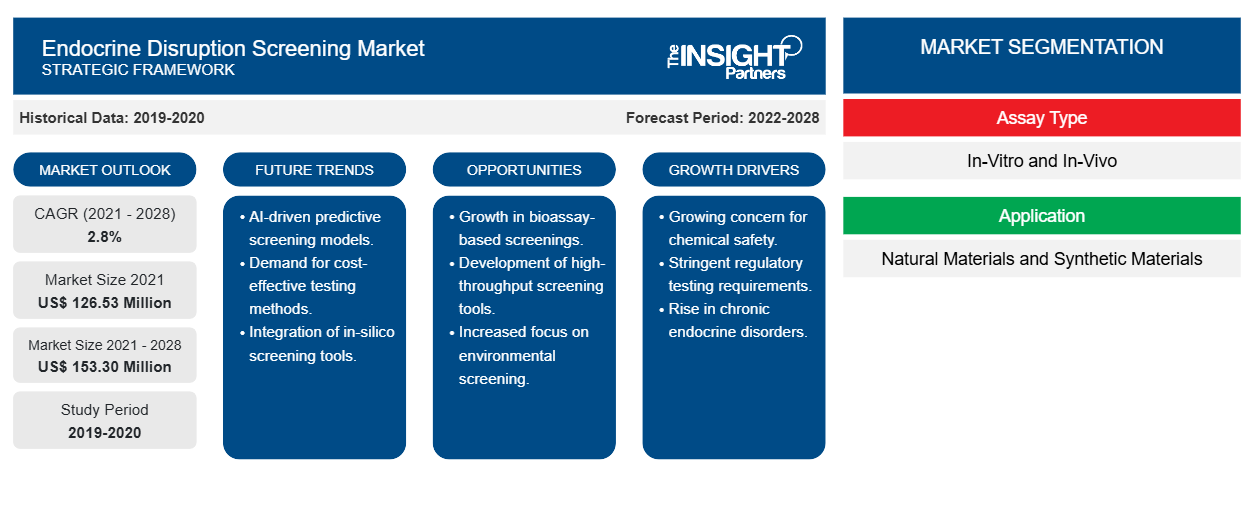Si prevede che il mercato degli screening per le alterazioni del sistema endocrino raggiungerà i 153,30 milioni di dollari entro il 2028, rispetto ai 126,53 milioni di dollari del 2021; si prevede che crescerà a un CAGR del 2,8% nel periodo 2021-2028.
Molte sostanze chimiche, sia naturali che artificiali, hanno il potenziale di imitare o interferire con il sistema endocrino, che regola gli ormoni del corpo. Queste sostanze chimiche, note come disruptori endocrini, sono state collegate a disturbi dello sviluppo, riproduttivi, cerebrali, immunologici e di altro tipo. Gli disruptori endocrini possono essere presenti in una varietà di articoli comuni, come alcune bottiglie e contenitori di plastica, rivestimenti metallici per lattine di cibo, detersivi, ritardanti di fiamma, cibo, giocattoli, cosmetici e pesticidi. Pesticidi, sostanze chimiche e tossine ambientali vengono esaminati utilizzando un metodo a due livelli per il loro potenziale effetto sui sistemi degli estrogeni, degli androgeni e degli ormoni tiroidei mediante lo screening degli disruptori endocrini.
La crescita del mercato dello screening per le alterazioni endocrine è attribuita alla crescente ricerca nel settore biotecnologico e alla crescente prevalenza di disturbi endocrini. Tuttavia, l'elevato costo della tecnologia di screening ostacola la crescita del mercato.
Personalizza questo report in base alle tue esigenze
Riceverai la personalizzazione gratuita di qualsiasi report, comprese parti di questo report, o analisi a livello nazionale, pacchetto dati Excel, oltre a usufruire di grandi offerte e sconti per start-up e università
- Scopri le principali tendenze di mercato in questo rapporto.Questo campione GRATUITO includerà analisi di dati che spaziano dalle tendenze di mercato alle stime e alle previsioni.
Approfondimenti di mercato
La crescente prevalenza di disturbi endocrini stimola il mercato dello screening per le alterazioni endocrine
Acromegalia (sovrapproduzione di ormone della crescita), obesità, sindrome metabolica, glicemia a digiuno alterata, intolleranza al glucosio alterata, osteoporosi, osteopenia, ipovitaminosi D lieve-moderata, disfunzione erettile, dislipidemia e tiroidite sono tra i disturbi endocrini che hanno una prevalenza collettiva di almeno il 5% tra gli adulti negli Stati Uniti. Di queste condizioni, i maschi hanno la più alta incidenza di disfunzione erettile, mentre le femmine hanno la più alta incidenza di osteopenia/osteoporosi. Il diabete mellito nei bambini e l'adenoma pituitario sono le condizioni meno comuni, che colpiscono meno dell'1% della popolazione statunitense. Il carcinoma adrenocorticale, il feocromocitoma e gli adenomi pituitari sono le condizioni con la più bassa incidenza. L'iperparatiroidismo e i disturbi della tiroide sono più comuni nelle donne. Il diabete mellito è più diffuso tra le minoranze etniche. Le malattie endocrine e metaboliche sono tra i disturbi umani moderni più comuni, in particolare negli Stati Uniti e in altri paesi che implementano ampi programmi di nutrizione e screening per gli individui ad alto rischio. I disturbi endocrini come iperparatiroidismo, ipogonadismo primario e secondario, deficit di GH e ipotiroidismo possono portare ad altri disturbi, come la malattia metabolica delle ossa e il diabete mellito. Pertanto, la crescente prevalenza e incidenza di tali condizioni stimolano la domanda di prodotti di screening per l'interruzione endocrina.
Informazioni basate sul tipo di analisi
Il mercato dello screening per l'alterazione endocrina, per tipo di test, è diviso in in-vitro e in-vivo. Il segmento in-vitro ha guidato il mercato nel 2021, contribuendo a una quota di mercato del 64,45%, e si prevede che manterrà il suo predominio durante il periodo di previsione per rappresentare una quota di mercato del 65,73% del fatturato complessivo generato nel 2028.
Approfondimenti basati sulle applicazioni
Per applicazione, il mercato dello screening per le alterazioni endocrine è diviso in materiali naturali e materiali sintetici. Nel 2021, il segmento dei materiali naturali deteneva una quota maggiore del mercato. Inoltre, si prevede che il mercato per lo stesso segmento crescerà a un CAGR più rapido del 3,1% nel periodo 2021-2028.
Fonte di informazioni basate sui rifiuti
Il mercato dello screening per le alterazioni endocrine, in base alla fonte dei rifiuti, è suddiviso in incenerimento e discarica, deflusso agricolo, effluenti industriali e municipali, effluenti di cartiere, prodotti di consumo e altri. Nel 2021, il segmento dell'incenerimento e della discarica deteneva la quota maggiore del mercato. Inoltre, si prevede che il mercato per lo stesso segmento crescerà al CAGR più rapido del 3,5% nel periodo 2021-2028.
Approfondimenti basati sul metodo
Il mercato dello screening per l'interruzione endocrina, in base al metodo, è segmentato in transattivazione del recettore degli estrogeni (ER), transattivazione del recettore degli androgeni (AR), modulazione del recettore degli androgeni (AR), legame del recettore degli estrogeni alfa (ER), legame del recettore degli estrogeni beta (ER), legame del recettore degli androgeni (AR), steroidogenesi, test dell'aromatasi e altri. Nel 2021, il segmento della transattivazione del recettore degli estrogeni (ER) ha detenuto la quota maggiore del mercato. Inoltre, si prevede che il mercato per lo stesso segmento crescerà al CAGR più rapido del 3,7% dal 2021 al 2028.transactivation, androgen receptor (AR) transactivation, androgen receptor (AR) modulation, estrogen receptor-alpha (ER) binding, estrogen receptor beta (ER) binding, androgen receptor (AR) binding, steroidogenesis, aromatase assay, and others. In 2021, the estrogen receptor (ER) transactivation segment held the largest share of the market. Moreover, the market for the same segment is expected to grow at the fastest CAGR of 3.7% from 2021 to 2028.
Approfondimenti basati sull'utente finale
Il mercato dello screening per le alterazioni endocrine, in base all'uso finale, è suddiviso in aziende farmaceutiche e biofarmaceutiche, aziende di cosmetici e prodotti per la casa, industria alimentare e industria chimica. Nel 2021, il segmento delle aziende farmaceutiche e biofarmaceutiche deteneva la quota maggiore del mercato. Inoltre, si prevede che il mercato per lo stesso segmento crescerà al CAGR più rapido del 3,3% nel periodo 2021-2028.
I lanci e le approvazioni di prodotti sono strategie comunemente adottate dalle aziende per espandere la loro presenza globale e i loro portafogli di prodotti. Inoltre, gli operatori del mercato dello screening per le alterazioni endocrine si concentrano sulla strategia di partnership per ampliare la loro clientela, il che, a sua volta, consente loro di mantenere il loro marchio in tutto il mondo.
Approfondimenti regionali sul mercato dello screening delle alterazioni endocrine
Le tendenze regionali e i fattori che influenzano il mercato dello screening per le alterazioni endocrine durante il periodo di previsione sono stati ampiamente spiegati dagli analisti di Insight Partners. Questa sezione discute anche i segmenti e la geografia del mercato dello screening per le alterazioni endocrine in Nord America, Europa, Asia Pacifico, Medio Oriente e Africa e America meridionale e centrale.

- Ottieni i dati specifici regionali per il mercato dello screening delle alterazioni endocrine
Ambito del rapporto di mercato sullo screening delle alterazioni endocrine
| Attributo del report | Dettagli |
|---|---|
| Dimensioni del mercato nel 2021 | 126,53 milioni di dollari USA |
| Dimensioni del mercato entro il 2028 | 153,30 milioni di dollari USA |
| CAGR globale (2021 - 2028) | 2,8% |
| Dati storici | 2019-2020 |
| Periodo di previsione | 2022-2028 |
| Segmenti coperti | Per tipo di analisi
|
| Regioni e Paesi coperti | America del Nord
|
| Leader di mercato e profili aziendali chiave |
|
Densità degli attori del mercato: comprendere il suo impatto sulle dinamiche aziendali
Il mercato dello screening per le alterazioni endocrine sta crescendo rapidamente, spinto dalla crescente domanda degli utenti finali dovuta a fattori quali l'evoluzione delle preferenze dei consumatori, i progressi tecnologici e una maggiore consapevolezza dei benefici del prodotto. Con l'aumento della domanda, le aziende stanno ampliando le loro offerte, innovando per soddisfare le esigenze dei consumatori e capitalizzando sulle tendenze emergenti, il che alimenta ulteriormente la crescita del mercato.
La densità degli operatori di mercato si riferisce alla distribuzione di aziende o società che operano in un particolare mercato o settore. Indica quanti concorrenti (operatori di mercato) sono presenti in un dato spazio di mercato in relazione alle sue dimensioni o al valore di mercato totale.
Le principali aziende che operano nel mercato dello screening delle alterazioni endocrine sono:
- BIOLOGIA CREATIVA
- XENOMETRIX AG
- FIUME CARLO
- EUROFINS SCIENTIFICO
- FABBRI
Disclaimer : le aziende elencate sopra non sono classificate secondo un ordine particolare.

- Ottieni una panoramica dei principali attori del mercato dello screening delle alterazioni endocrine
Il rapporto suddivide il mercato dello screening delle alterazioni endocrine come segue
Mercato dello screening delle alterazioni endocrine – per tipo di analisi
- In vitro
- In vivo
Mercato dello screening delle alterazioni endocrine – per applicazione
- Materiali naturali
- Materiali sintetici
Mercato dello screening delle alterazioni endocrine – per fonti di rifiuti
- Incenerimento e discarica
- Deflusso agricolo
- Effluenti industriali e municipali
- Effluenti della cartiera
- Prodotti di consumo
- Altri
Mercato dello screening delle alterazioni endocrine – per metodo
- Transattivazione del recettore degli estrogeni (ER).
- Transattivazione del recettore degli androgeni (AR)
- Modulazione del recettore degli androgeni (AR)
- Legame con il recettore alfa degli estrogeni (ER-alfa).
- Legame con il recettore beta degli estrogeni (ER-beta).
- Legame del recettore degli androgeni (AR)
- Steroidogenesi
- Saggio dell'aromatasi
- Altri
Mercato dello screening delle alterazioni endocrine – per utente finale
- Aziende farmaceutiche e biofarmaceutiche
- Industria chimica
- Industria alimentare
- Aziende di cosmetici e prodotti per la casa
Mercato dello screening per le alterazioni endocrine – per area geografica
- America del Nord
- NOI
- Canada
- Messico
- Europa
- Regno Unito
- Germania
- Francia
- Italia
- Spagna
- Resto d'Europa
- Asia Pacifico
- Cina
- Giappone
- India
- Australia
- Corea del Sud
- Resto dell'Asia Pacifica
- Medio Oriente e Africa
- Emirati Arabi Uniti
- Arabia Saudita
- Sudafrica
- Resto del Medio Oriente e Africa
- America del Sud e Centro
- Brasile
- Argentina
- Resto del Sud e Centro America
Profili aziendali
- BIOLOGIA CREATIVA
- XENOMETRIX AG
- LABORATORI DI CHARLES RIVER, INC.
- EUROFINS SCIENTIFIC Ltd.
- FABBRI
- SGS SA
- JRF GLOBALE
- NUTRISCIENZE DI MÉRIEUX
- ALPHA ANALYTICAL INC.
- Analisi storica (2 anni), anno base, previsione (7 anni) con CAGR
- Analisi PEST e SWOT
- Valore/volume delle dimensioni del mercato - Globale, Regionale, Nazionale
- Industria e panorama competitivo
- Set di dati Excel
Report recenti
Testimonianze
Motivo dell'acquisto
- Processo decisionale informato
- Comprensione delle dinamiche di mercato
- Analisi competitiva
- Analisi dei clienti
- Previsioni di mercato
- Mitigazione del rischio
- Pianificazione strategica
- Giustificazione degli investimenti
- Identificazione dei mercati emergenti
- Miglioramento delle strategie di marketing
- Aumento dell'efficienza operativa
- Allineamento alle tendenze normative





















 Ottieni un campione gratuito per - Mercato dello screening per le alterazioni del sistema endocrino
Ottieni un campione gratuito per - Mercato dello screening per le alterazioni del sistema endocrino